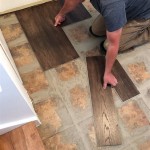Installing Laminate Flooring on Uneven Floor
Transforming an uneven floor into a stunning and level surface with laminate flooring is a rewarding home improvement project. By meticulously following these essential aspects, you can achieve a professional-looking installation that will enhance the aesthetic appeal and comfort of your space.
1. Assess the Unevenness: Begin by determining the severity of the unevenness using a level or straight edge. Identify the high and low spots, and measure the variances to determine the appropriate leveling compound required.
2. Prepare the Floor: Remove all existing floor coverings, baseboards, and moldings. Clean the subfloor thoroughly to eliminate any dirt, debris, or contaminants that could compromise adhesion. Repair any structural damage or gaps with appropriate materials.
3. Apply Leveling Compound: Mix the self-leveling compound according to the manufacturer's instructions. Pour the compound onto the floor, starting from the highest point and working towards the lowest. Use a notched trowel to spread the compound evenly, filling the dips and creating a level surface.
4. Allow Drying Time: Allow the leveling compound to dry completely before proceeding with the laminate installation. The drying time may vary depending on the type of compound used and the thickness of the application. Follow the manufacturer's recommended waiting period.
5. Install Underlayment: Roll out the underlayment over the leveled subfloor, ensuring it is smooth and wrinkle-free. The underlayment provides additional cushioning, sound dampening, and moisture protection.
6. Acclimate Laminate Flooring: Before installing the laminate flooring, allow it to acclimate to the room's temperature and humidity conditions for at least 48 hours. This helps prevent expansion or contraction issues after installation.
7. Start Installation: Begin laying the laminate flooring planks from a corner of the room, ensuring the tongue-and-groove edges interlock securely. Use a tapping block and hammer to gently tap the planks into place. Install the first few rows parallel to the longest wall for stability.
8. Cut Planks as Needed: Measure and cut the laminate planks to fit around obstacles or against walls. Use a circular saw or a laminate cutter for precise cuts. Leave a small expansion gap around the perimeter of the room for future movement.
9. Install Baseboards and Moldings: After all the laminate flooring is installed, reattach the baseboards and moldings to conceal the expansion gap and provide a finished look. Secure them firmly to the wall and ensure a snug fit against the flooring.
By following these essential aspects, you can successfully install laminate flooring on an uneven floor, achieving a level and visually appealing surface. Remember to consult the manufacturer's instructions for specific products and materials, and consider consulting with a professional for guidance on more complex installations.

Can We Install Laminate Flooring On An Uneven Floor Singapore

Can You Install Laminate On An Uneven Floor Ready To Diy

Flooring Fitting Experts One Wood Floors

Ask The Builder Blame Installation For Laminate Flooring S Problems

How To Lay Laminate Flooring Over An Uneven Floor Hunker

How To Lay Laminate Flooring On Uneven Concrete Floor Installing Laying Contractor

Should We Be Concerned About Vinyl Plank Installed Over Uneven Floors

Can You Install Laminate On An Uneven Floor Ready To Diy

Common Mistakes When Laying Laminate Flooring Next Day Floors

What S The Best Flooring For Uneven Floor Surfaces Floortheory
See Also







